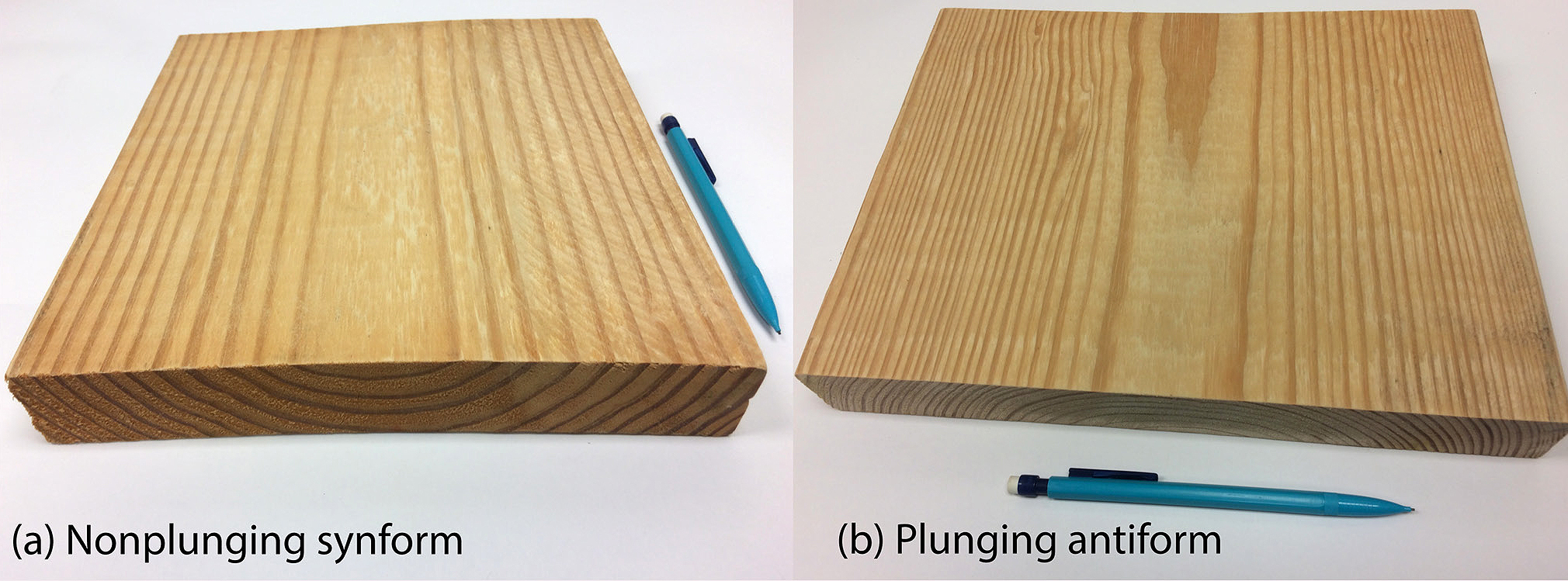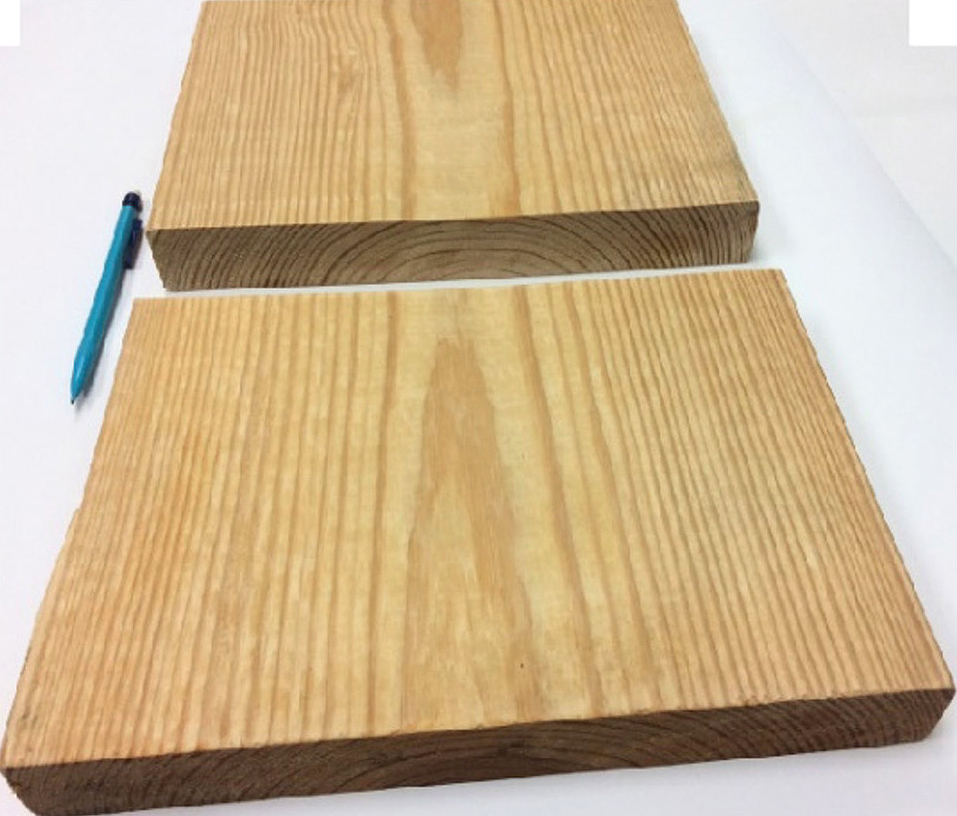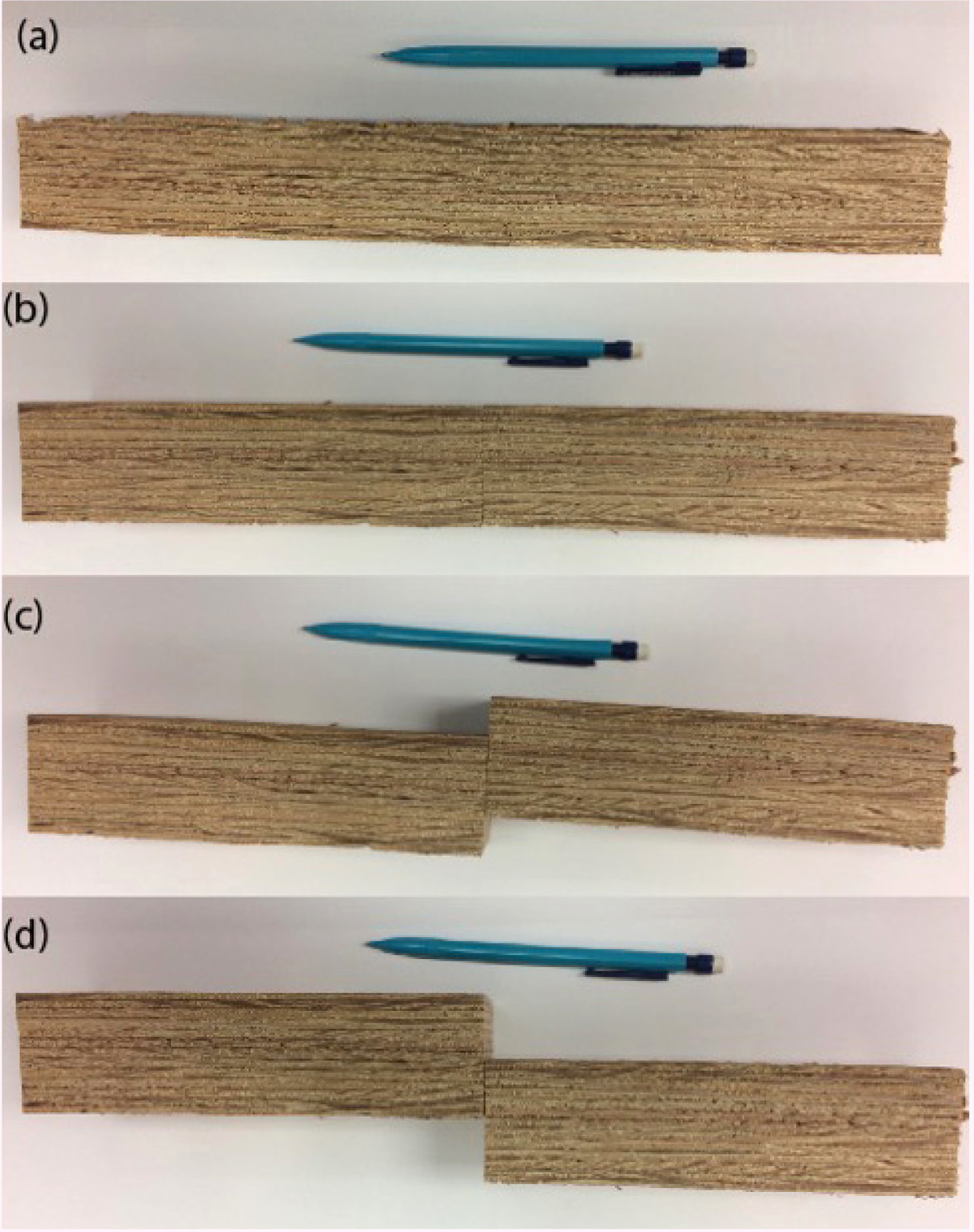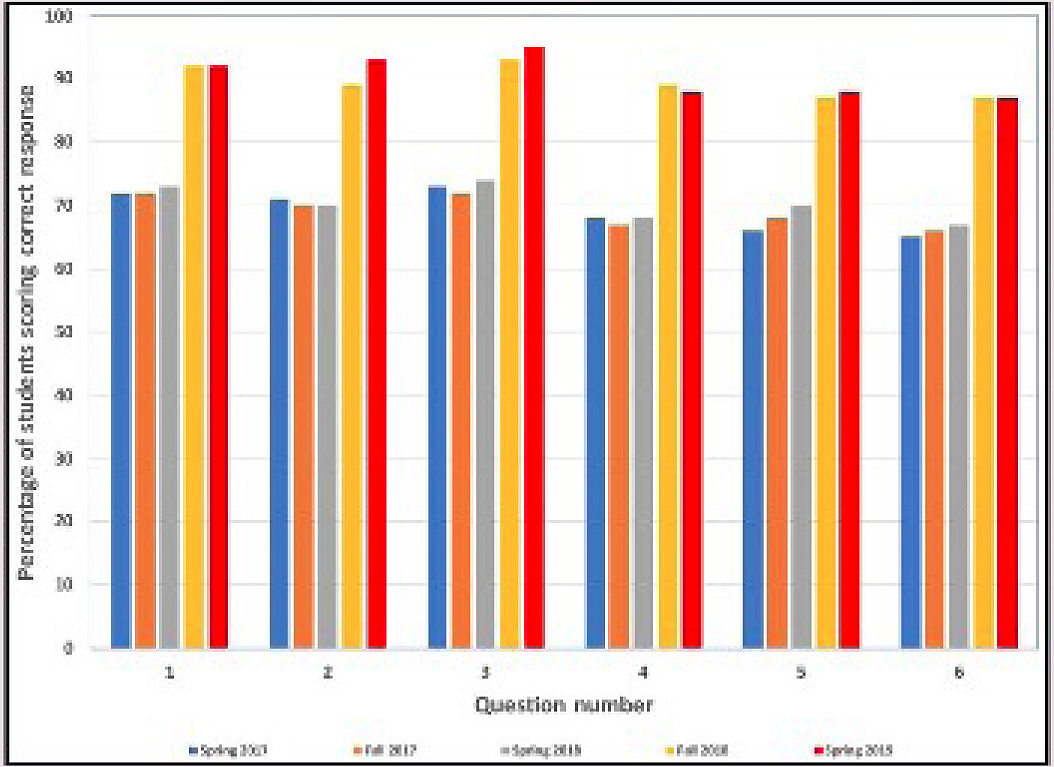feature
Using Growth Rings on Wooden Blocks and Plywood to Enhance Students’ Spatial Reasoning Skills
Journal of College Science Teaching—May/June 2023 (Volume 52, Issue 5)
By Jeff B. Chaumba and Josphine Chaumba
Spatial reasoning is one of the most challenging skills to master in the science, technology, engineering, and mathematics (STEM) fields. This article reports the results of a teaching intervention that involved using wooden blocks to enhance the development of spatial reasoning in an undergraduate-level introductory geology course. Wooden blocks with growth rings that mimic folded rock layers and plywood that mimicked horizontal layers were used as aids to teach geologic structures in the fall 2018 and spring 2019 semesters. The teaching intervention was evaluated by comparing the exam scores of students who had taken the course before and after the use of the wooden blocks teaching tool. Comparison of students’ test scores in spring 2017 with fall 2018 and spring 2019 showed substantial improvements, a 20%–25% increase in their geologic structure questions. Results from an independent samples t-test also suggest that the new teaching tool was effective in both semesters.
Spatial reasoning may be defined as a set of mental skills that enable human beings to make inferences about space and the relationships that exist between objects. Spatial reasoning deals with shapes of objects, their locations and relations, and the paths they take as they move. The ability to think spatially is considered one of the most critical building blocks of success in science, technology, engineering, and mathematics (STEM) fields (Gagnier & Fisher, 2016). Students who possess spatial skills enrich their ability to develop literacy and numerical skills that are necessary in STEM fields (Newcombe, 2017). Human beings frequently depend on spatial reasoning when we navigate in new areas or travel to a supermarket for shopping, for example. Human beings use spatial reasoning when imagining what an object might look like when it is resized or rotated. Uttal et al. (2013) and Gold et al. (2018) concluded that although spatial skills are often assumed to be innate, they can be improved. It has been concluded that spatial skills strongly predict who will go into STEM fields (Uttal & Cohen, 2012). The formation of mental images and visual abilities are involved in spatial visualization (Mathewson, 1999).
In the geosciences context, Kastens and Ishikawa (2006) describe spatial reasoning as recognizing, observing, recording, describing, classifying, remembering, and communicating two-dimensional (2D) or three-dimensional (3D) shapes, structures, orientations, and positions of objects, properties, or processes, among other tasks. Geoscience students, therefore, are also expected to produce, use, and interpret spatial representations such as folds, cross-sections, maps, and 3D models. A typical geoscience course has many tasks that require effective spatial reasoning (Ishikawa & Kastens, 2005). Consequently, an understanding of geologic structures is an important part of any geoscience course for college students, regardless of their major, yet several students find geologic structures to be the most difficult section of an introductory geoscience course (Wright et al., 2011). Geologic structures tend to require the use of spatial reasoning more than any other topic in an introductory geoscience course (Wright et al., 2011).
Geoscience instructors, however, often find that a large number of students struggle with these kinds of spatial tasks and may not improve substantially even with practice (e.g., Ishikawa & Kastens, 2005). There are many rewards and drawbacks for students learning about geologic structures. Orion et al. (1997), for example, observed that the ability to imagine cross-sections and the internal structure of 3D forms, known as visual penetration ability, is important for understanding geologic structures, as students with the capacity to visualize objects in 3D outperform those who lack that capacity. Uttal and Cohen (2012) observed that students with the ability to think spatially possess the skills needed to enter STEM fields.
Less than 40% of U.S. students who start college with the intention of majoring in a STEM field graduate with a STEM degree (President’s Council of Advisors on Science and Technology, 2012). Active learning occurs when instructors build learner participation into classes (McConnell et al., 2003). Research findings suggest that instructors can foster the growth of reasoning skills and promote science literacy by incorporating active-learning strategies into their classrooms. Squashed coins by trains, for example, have also been used to illustrate structural analysis when they are compared with original and undeformed coins (Kenah, 1994). A moist pound cake can be used to illustrate some geologic structures (Wagner, 1987). Cardboard and paper have also been used to enhance spatial reasoning by having students make 3D models using these materials (Cronin, 2019). Active learning is responsible for higher test scores in comparison with traditional lecturing, prompting a reevaluation of how professors teach in STEM classrooms (Freeman et al., 2014; Ruiz-Primo et al., 2011).
In an effort to foster active learning, Caballero and Harris (1996) sawed wooden blocks at various angles to represent shapes of tectonic plates with the aim to help 3D visualization. With the increasing trend toward using open educational resources in education (Brown & Adler, 2008), the wooden blocks methodology discussed in this article would provide an alternative to the use of the cardboard models that are provided with purchased laboratory books.
In an undergraduate-level introductory geology course taught by one of us, which meets the university’s general education requirements, the usefulness of wooden blocks in helping develop students’ spatial thinking skills was explored because the students have been obtaining scores of 65%–74% in the geologic structures portion of the course. The goal of the study was to devise alternative methods of teaching the geologic structures portion of this course, which would possibly promote students’ spatial visualization and improve their understanding and test scores in this portion of the course.
Getting more undergraduates attracted to geology is a daunting task at our institution, where a mere 1% of students major in geology. We hoped that active-learning strategies such as the wooden blocks method may stimulate students’ interest in geology through a better understanding of spatial reasoning. Because these blocks are relatively inexpensive and easy to obtain, every geoscience department and instructor can easily have access to, and use, similar blocks for enhancing students’ understanding of spatial reasoning and geologic structures. The wooden blocks methodology enables students to better visualize folded and faulted structures by observing tree rings in 3D in wooden blocks that bear striking resemblances to layered rocks. Furthermore, this method promotes a teaching method that transitions from instruction to engagement of students in learning the concepts and processes in STEM fields (National Science Foundation, 1996). The theoretical basis for this study falls under teacher learning, which involves developing and integrating one’s knowledge base about content, teaching, and learning and becoming enculturated into a range of teacher practices (Davis & Krajcik, 2005).
Teaching instrument
Various types of inexpensive wooden boards can be purchased at any home improvement store or are available as carpentry waste at construction sites. The wooden boards can then be trimmed into blocks approximately 15 centimeters to 20 centimeters in length that are easy to handle yet big enough for students to easily see the tree rings. White ash wooden boards (measuring approximately 1.91 cm thick by 7.6 cm wide and 61 cm long) were sawed into approximately 10 cm blocks that can be hand-held easily for demonstrating the 3D nature of layered rocks using tree rings on the blocks. For mimicking planar sedimentary layers, students used 1.27 cm or 1.9 cm thick Baltic birch plywood measuring 30 cm wide by 76 cm long. These wooden blocks and plywood are fairly inexpensive (less than $20 in 2021). To saw these wooden blocks, the instructor could use a Kobalt 7 1/4-inch 15-amp corded circular saw with brake magnesium shoe.
Evaluation of the teaching method
To evaluate the effect of the teaching instrument on student learning, a set of six questions on geologic structures were included in the final examination of the introductory geology class that the first author taught. The class has no prerequisite, and mostly freshmen student enroll, with 32 enrolled students each semester. Students took the exam from spring 2017 before the onset of using the wooden blocks in fall 2018 and spring 2019. The percentage of students who got correct responses to the six questions was calculated for 3 semesters and compared with the performance of the same questions for 2 semesters after the use of wooden blocks in teaching geologic structures was employed. The students’ scores were analyzed using descriptive statistics that included frequency, percent, and standard deviation. Potential differences in the scores before and after the use of the teaching aid were assessed using t-tests and correlation analyses.
A wooden block with tree rings can be used to represent, in 3D, any part of the crust composed of folded sedimentary layers, with the tree rings representing beds or bedding planes. The instructor reviews the definitions of 1D, 2D, 3D, and projections. With a wooden block held in one hand, the instructor points out various aspects of the wooden block.
Description of study participants
Over the 5 semesters under study, enrollment in the classes was composed of approximately (~) 61% White students, ~16% Native American students, ~14% Black students, 5% Latinx students, and ~3% Asian students (Table 1). Although ~50% of the students across the two classes (each with 32 students) across 5 semesters were true freshmen, the remainder included students in their sophomore, junior, and senior years, in decreasing order. During the first 3 semesters (fall 2017, spring 2018, and fall 2018), wooden blocks were not used as teaching tools. Wooden blocks were used to teach about geologic structures in the latter 2 semesters the class was taught (fall 2018 and spring 2019). The class was taught five times by the same instructor.
Geologic structures illustrated using wooden blocks
The surface, or plan, of a wooden block can afford students to have a bird’s-eye, 2D view of a wooden block, as shown in Figure 1a. One can rotate the block to expose the other face (Figure 1b). When one can view the length, width, and height of an object, as shown in Figure 1c, it is possible to determine the length and width of each of the three faces to form a 3D figure where each tree growth ring can be traced on two faces. Where growth rings form downward-closing folds, synforms are produced (Figure 2a), whereas antiforms are produced where growth rings form upward-closing folds (Figure 2b). Nonplunging (Figure 2a) and plunging (Figure 2b) folds can be demonstrated by growth rings to replicate nonplunging synforms (Figure 2a) and plunging antiforms (Figure 2b), respectively.

Images showing three different views of a wooden block.
Note. (a) View of one block with a 2D showing where growth rings are only visible as lines on a single face. (b) View of the plan and any other additional face such as the edge. (c) View of the length, width, and height of a 3D figure.

Images illustrating nonplunging syncline and plunging anticline.
Note. (a) Growth rings form downward-closing folds called synforms. The two growth rings on either side of a fold hinge are parallel to form a nonplunging synforms. (b) Antiforms are produced where growth rings form upward-closing folds where the two growth rings are plunging to form a plunging antiform.
The continuity of growth rings is a good analogue for the lateral continuity of folded rock layers that resemble either antiforms (Figure 3) or synforms (Figure 4). Furthermore, any alternations in the plunging direction of any beds of sedimentary layers can be illustrated by the behavior of growth rings on some wooden blocks that either resemble antiforms (Figure 3) or synforms (Figure 4). Holding any two wooden blocks so that their edges are in contact can be a good representation of how synforms and antiforms are related, as shown in Figure 5. To illustrate how jointing and faulting can affect any vertically dipping beds, a block of plywood can be used (Figure 6a–d) where each wooden layer can represent a rock layer. An uncut block of plywood (Figure 6a) would represent any unjointed beds of sedimentary rocks, which can then be subsequently jointed but with no displacement along the fracture (Figure 6b).

Continuity of growth rings that represent the lateral continuity of folded sedimentary layers to resemble plunging antiforms.

Continuity of growth rings represents the lateral continuity of folded sedimentary layers to resemble plunging synforms.

Blocks held together with edges in contact, representing a combination of synforms and antiforms.

Use of a block of plywood to represent sedimentary layers.
Note. (a) uncut or intact plywood; (b) cut or “jointed” plywood with no displacement; (c) faulted plywood representing left-lateral fault; and (d) faulted plywood representing right-lateral fault.
Any subsequent displacement along the joint leads to the formation of faults (Figure 6c and 6d). The type of movement along a fault determines whether either a left-lateral fault (Figure 6c) or a right-lateral fault (Figure 6d) is produced. By determining the direction of motion as well as deducing the amount of displacement on either side of any two dislocated blocks of plywood, students can easily interpret the type of fault and determine the amount of displacement or offset (Figure 6c and 6d).
Results of effectiveness of using wooden blocks
Pretest scores were comparable in all semesters under study (Table 2). Results comparing the performance of students before and after implementing the use of wooden blocks in teaching geologic structures are shown in Tables 2 and 3 and Figure 7. Final examination scores by students increased by between 20% and 25% after the implementation of wooden blocks as shown in Table 3. No data were collected on student performances by different racial groups. However, based on the overall course grades, the results indicate comparable increased performances by all racial groups.

Bar graph of percentages of correct student responses for each of six questions during the 5 semesters of study.
Note. A marked increase is observed for the fall 2018 and spring 2019 semesters, during which geologic structures were taught using wooden blocks.
Discussion
This study evaluated the effectiveness of a new teaching method that involved the use of wooden blocks to teach geologic structures. Students who completed the course after the introduction of the wooden blocks teaching tool had higher exam scores in comparison with students who completed the course prior to the blocks’ introduction, suggesting the effectiveness of the wooden blocks teaching tool. Results from student performances in this study are consistent with better outcomes for students who participated in hands-on training interventions compared with those who did not (Gold et al., 2018). The wooden blocks method described in this article, therefore, can potentially greatly facilitate spatial reasoning.
Because the final examination scores for the 3 semesters prior to using wooden blocks in the researchers’ teaching compare well but are below those after use of wooden blocks in teaching (fall 2018 and spring 2019 semesters; Table 3), the much-improved performances can be ascribed to the use of wooden blocks in teaching this course. Students had a higher level of engagement in class in comparison to when the researchers did not use geologic structures in their teaching of geologic structures. This higher level of engagement was interpreted as a reflection of a better understanding by the students of spatial reasoning in comparison with the lower level of engagement by students who performed lower in tests prior to the use of wooden blocks.
The improved performances by students since the implementation of wooden blocks in teaching were recorded in all six questions dealing with geologic structures (Table 3; Figure 7). The results of the independent samples t-test indicated statistically significant differences between the scores for both the fall 2018 and spring 2019 semesters compared with spring 2017, suggesting that the new teaching tool was effective. Although the researchers have described the use of tree rings on wooden blocks related to geologic structures, they envision the applicability of wooden blocks in teaching spatial reasoning in other STEM fields. This can involve symmetry, 2D and 3D shape, and the role of technological tools in mapping and location in geometry (Mulligan, 2015), physics (Chang et al., 2014), organic chemistry (Small & Morton, 1983), and engineering (Contero et al., 2005).
Spatial reasoning is a topic that is encouraged not only in the geological sciences (Mogk & Goodwin, 2012; Ormand et al., 2014) but also in other STEM fields such as astronomy (Eriksson, 2019) and physics (Kozhevnikov et al., 2007). In the latter STEM fields, wooden blocks can be customized, given the linkage between spatial reasoning and STEM learning (Newcombe, 2017). A simple wooden block can greatly facilitate students’ spatial visualization skills. Although spatial thinking research for upper-level geology classes has been documented (Ormand et al., 2017), little has been done for introductory and nonmajor courses from which potential majors are often recruited. It is hoped that the activities documented here may be of help in attracting interest in STEM education, thereby drawing students to major in STEM fields.
Conclusion
The use of tree rings on wooden blocks and plywood helped the researchers’ students’ understanding of geologic structures in comparison with their understanding before their use. Students’ class participation was also significantly boosted through the use of these wooden blocks. The use of wooden blocks in teaching geologic structures may significantly enhance students’ spatial reasoning abilities.
Jeff B. Chaumba (jeff.chaumba@uncp.edu) is an associate professor in the Department of Geology and Geography at the University of North Carolina at Pembroke in Pembroke, North Carolina. Josphine Chaumba (jchaumba@tarleton.edu) is an associate professor in the Department of Social Work and Communication Disorders at Tarleton State University in Fort Worth, Texas.
Earth & Space Science Instructional Materials Interdisciplinary New Science Teachers Teaching Strategies Postsecondary

